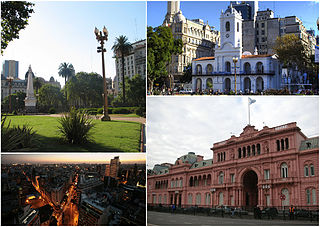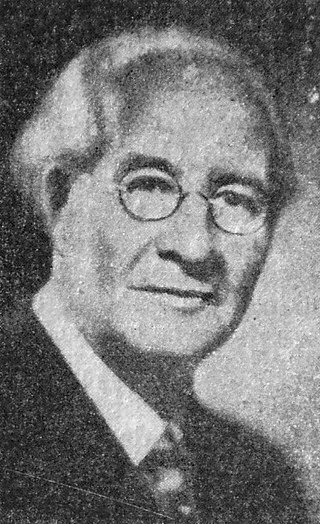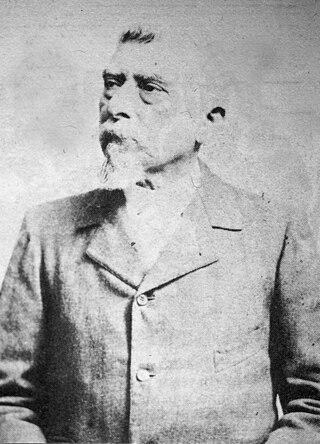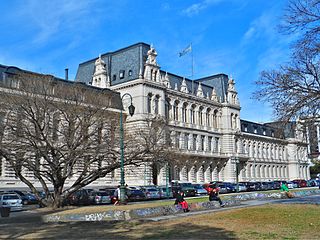
Recoleta is a barrio or neighborhood of Buenos Aires, Argentina, located in the northern part of the city, by the Río de la Plata. The area is perhaps best known to be the home of the distinguished Recoleta Cemetery. It is a traditional upper-class and conservative neighborhood with some of the priciest real estate in the city, known for Paris-style townhouses, lavish former palaces and posh boutiques.

Retiro is a barrio or neighborhood in Buenos Aires, Argentina. Located in the northeast end of the city, Retiro is bordered on the south by the Puerto Madero and San Nicolás, and on the west by the Recoleta.

The Mariano Moreno National Library is the largest library in Argentina. It is located in the barrio of Recoleta in Buenos Aires. The library is named after Mariano Moreno, one of the ideologists of the May Revolution and its first director.

San Martín Palace is located facing Plaza San Martín in the Retiro neighbourhood of Buenos Aires, Argentina and serves as the Ceremonial Headquarters for the Ministry of Foreign Relations.

Avenida Alvear is an upscale thoroughfare in Buenos Aires, Argentina. Located in the neighbourhood of Recoleta, it extends for seven blocks, from the Plazoleta Carlos Pellegrini to Alvear Plaza. The avenue is famous not only for the most exclusive representatives of haute couture, but also for its numerous demi-palaces and extensive presence of the French academy architecture that was so much in vogue in uptown Buenos Aires at the turn of the 20th century. The Buenos Aires Legislature approved the bill to declare it as a Historic Protection Area. A study by the U.S. television network NBC, placed it among the world's five most distinguished avenues.

Monserrat or Montserrat is a neighbourhood in the east of the Buenos Aires CBD. The district features some of the most important public buildings in Buenos Aires, including city hall, the city legislature, Casa Rosada, the Colegio Nacional de Buenos Aires and the Libertador Building, among others.

Avenida Santa Fe is one of the principal thoroughfares in Buenos Aires, Argentina. The artery is essential to the imaginary axis of Barrio Norte in Buenos Aires, comprising the areas influenced by the route of the avenue through Retiro, Recoleta and Palermo neighborhoods, it is considered one of the main shopping and strolling areas of the city, its many boutiques range from elegant to edgy, which has led it to be dubbed the 'Avenue of Fashion'. Upscale Alto Palermo, at Avenida Coronel Díaz, is one of the city's best-known vertical malls. Avenida Santa Fe is also an attraction for its architecture, strongly reminiscent of Paris. Its name pays homage to the eponymous province in Argentina.

Córdoba Avenue is one of the principal thoroughfares in Buenos Aires, Argentina.

Callao Avenue is one of the principal thoroughfares in Buenos Aires, Argentina.

The Palace of Running Waters is an architecturally significant water pumping station in Buenos Aires, Argentina and the former headquarters of Obras Sanitarias de la Nación. It is currently administered by Agua y Saneamientos Argentinos (AySA).

The Ministry of Public Works Building, now known as the Ministry of Health Building is a public building in the rationalist style located on the intersection of 9 de Julio Avenue and Belgrano Avenue, in the neighborhood of Monserrat, in Buenos Aires, Argentina. It is currently used by the Argentine Ministry of Health.

Pablo Pizzurno was an Argentinian educator who laid the foundations of the national primary education.

The Palacio Haedo is a 19th-century building in the Retiro neighborhood of Buenos Aires, Argentina. It is located on the Avenida Santa Fe, to the south of the Torre Monumental and the Plaza San Martín, in close proximity to the Consulate of Colombia and the Plaza Hotel. It was built as a residence for the Haedo family by architects Passeroni and Brizuela in the Neo-Gothic style.

José Christiano de Freitas Henriques Junior (1832–1902), mostly known as Christiano Junior, was a Portuguese-born photographer. He was one of the most prominent photographers in Argentina in the 19th century.
The Monumento ecuestre a Bartolomé Mitre located on Plaza Mitre, a landmark in the Recoleta neighbourhood of Buenos Aires, Argentina, and was raised in honor of Bartolomé Mitre (1821-1906).

The Buenos Aires Central Post Office building, now the Kirchner Cultural Centre, was the seat of the Correo Argentino until 2005. It is located in the San Nicolás, Buenos Aires neighborhood of Buenos Aires, Argentina.

The Ministry of Education of Argentina was a ministry of the national executive power that oversaw education policies on all educational levels, alongside the governments of the twenty-three provinces of Argentina and the City of Buenos Aires.

The Ministry of Public Works of Argentina was a ministry of the national executive power that oversaw and advised on the elaboration and maintenance of roadways, urban and hydraulic infrastructure and other types of public works.

The Ministry of Productive Development of Argentina was a ministry of the national executive power overseeing and advising on the promotion of industrial policies and foreign trade in Argentina.



















